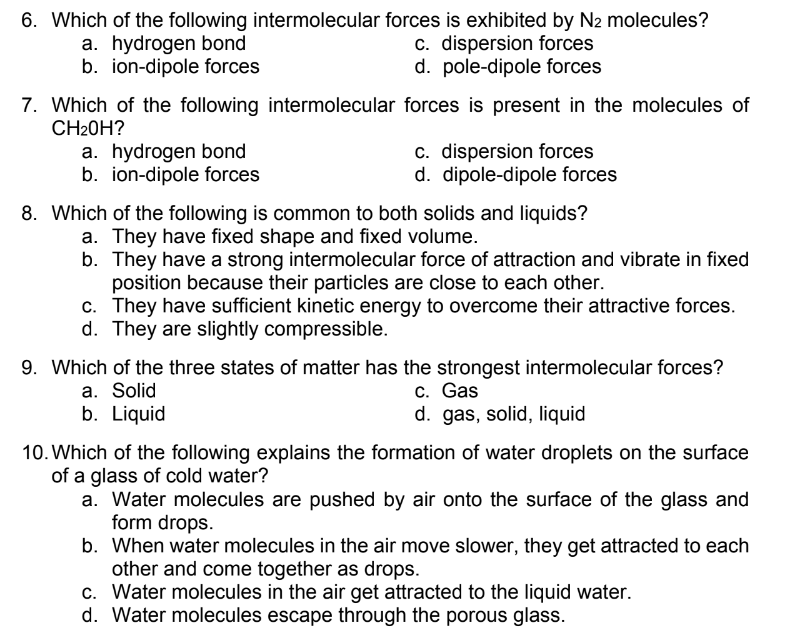b. ion-dipole forces d. pole-dipole forces 7. Which of the following intermolecular forces is present in the molecules CH20H? a. hydrogen bond b. ion-dipole forces c. dispersion forces d. dipole-dipole forces 8. Which of the following is common to both solids and liquids? a. They have fixed shape and fixed volume. b. They have a strong intermolecular force of attraction and vibrate in fix
b. ion-dipole forces d. pole-dipole forces 7. Which of the following intermolecular forces is present in the molecules CH20H? a. hydrogen bond b. ion-dipole forces c. dispersion forces d. dipole-dipole forces 8. Which of the following is common to both solids and liquids? a. They have fixed shape and fixed volume. b. They have a strong intermolecular force of attraction and vibrate in fix
Chapter10: Liquids And Solids
Section: Chapter Questions
Problem 1RQ: What are intermolecular forces? How do they differ from intramolecular forces? What are...
Related questions
Question
7,8,9 and 10 only

Transcribed Image Text:6. Which of the following intermolecular forces is exhibited by N2 molecules?
a. hydrogen bond
b. ion-dipole forces
c. dispersion forces
d. pole-dipole forces
7. Which of the following intermolecular forces is present in the molecules of
CH20H?
a. hydrogen bond
b. ion-dipole forces
c. dispersion forces
d. dipole-dipole forces
8. Which of the following is common to both solids and liquids?
a. They have fixed shape and fixed volume.
b. They have a strong intermolecular force of attraction and vibrate in fixed
position because their particles are close to each other.
c. They have sufficient kinetic energy to overcome their attractive forces.
d. They are slightly compressible.
9. Which of the three states of matter has the strongest intermolecular forces?
a. Solid
b. Liquid
c. Gas
d. gas, solid, liquid
10. Which of the following explains the formation of water droplets on the surface
of a glass of cold water?
a. Water molecules are pushed by air onto the surface of the glass and
form drops.
b. When water molecules in the air move slower, they get attracted to each
other and come together as drops.
c. Water molecules in the air get attracted to the liquid water.
d. Water molecules escape through the porous glass.
Expert Solution
This question has been solved!
Explore an expertly crafted, step-by-step solution for a thorough understanding of key concepts.
Step by step
Solved in 2 steps

Knowledge Booster
Learn more about
Need a deep-dive on the concept behind this application? Look no further. Learn more about this topic, chemistry and related others by exploring similar questions and additional content below.Recommended textbooks for you


Chemistry: An Atoms First Approach
Chemistry
ISBN:
9781305079243
Author:
Steven S. Zumdahl, Susan A. Zumdahl
Publisher:
Cengage Learning

Chemistry
Chemistry
ISBN:
9781305957404
Author:
Steven S. Zumdahl, Susan A. Zumdahl, Donald J. DeCoste
Publisher:
Cengage Learning


Chemistry: An Atoms First Approach
Chemistry
ISBN:
9781305079243
Author:
Steven S. Zumdahl, Susan A. Zumdahl
Publisher:
Cengage Learning

Chemistry
Chemistry
ISBN:
9781305957404
Author:
Steven S. Zumdahl, Susan A. Zumdahl, Donald J. DeCoste
Publisher:
Cengage Learning

Chemistry for Engineering Students
Chemistry
ISBN:
9781337398909
Author:
Lawrence S. Brown, Tom Holme
Publisher:
Cengage Learning

General Chemistry - Standalone book (MindTap Cour…
Chemistry
ISBN:
9781305580343
Author:
Steven D. Gammon, Ebbing, Darrell Ebbing, Steven D., Darrell; Gammon, Darrell Ebbing; Steven D. Gammon, Darrell D.; Gammon, Ebbing; Steven D. Gammon; Darrell
Publisher:
Cengage Learning

World of Chemistry, 3rd edition
Chemistry
ISBN:
9781133109655
Author:
Steven S. Zumdahl, Susan L. Zumdahl, Donald J. DeCoste
Publisher:
Brooks / Cole / Cengage Learning